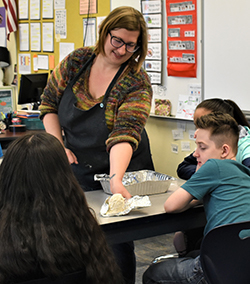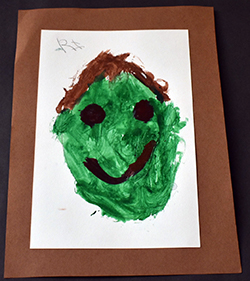Elijah Brown stroked the garment on a tiny clay bust sitting on the table in front of him. Elijah, a student in Lisa Kotarski’s class at Godwin Heights Middle School, talked about his likes – Sonic the Hedgehog, some (but not all) of the characters from Disney on Ice – while handling the bust, which he had sculpted, painted and outfitted.
“That guy?” he said, patting the bust. “It’s E.B.”
Across from where Elijah works, Kotarski helped Aaron Powers choose yarn for his sculpture’s hair.
“Is your hair long or short?” Kotarski asked him.
“Short.”
Before the mandated school closure, the classroom was in the middle of a 10-week artist residency offered by Artists Creating Together (ACT). Each week Annalise Hammerlund, the artist-in-residence who worked with Kotarski’s class, visited the classroom to lead students in an art lesson that challenged them to learn a bit more about themselves and to express themselves through art.
A look in the mirror

Kotarski, who teaches students with autism spectrum disorder, applied for the residency last fall, and hers was one of 24 classrooms chosen to receive 10 hours of instruction, free of charge, from a professionally trained artist.
“It’s been really fun,” said Kotarski, who added that her students sometimes struggle with self-awareness. “I think it’s good for my students to practice art skills and see what they can create.”
For one lesson, Hammerlund, who has a master’s degree in expressive arts therapy and mental health counseling, had students use a mirror to see themselves while painting a self-portrait.
“That can be an interesting challenge for anyone,” said Hammerlund, who has worked extensively with people with limited verbal ability. “Even just focusing on ‘what color hair do you have?’ and being able to identify and explain things about ourselves – it’s been a fun way to see them explore and grow.”

Tailor-made Teaching
Maggie Santos is a “link” or peer mentor, who works with Elijah, a student with autism, in class to offer support.
“Elijah enjoys art very much. He really likes to make his own characters and design them in his own original way,” said Maggie, who also participated in the art lessons.
The artist-in-residence program was tailored to the needs of each class, said Krista Pischner-Coon, program coordinator for ACT. For example, a class where students have multiple impairments or do not have the use of their arms and legs might receive more hand-over-hand instruction.
“Every classroom looks a little bit different,” said Pischner-Coon.
The program is a popular one, with about 50 applicants this year. While ACT was limited to 24 recipients this year, said Pischner-Coon, classrooms that do not receive a grant could participate for a fee.












